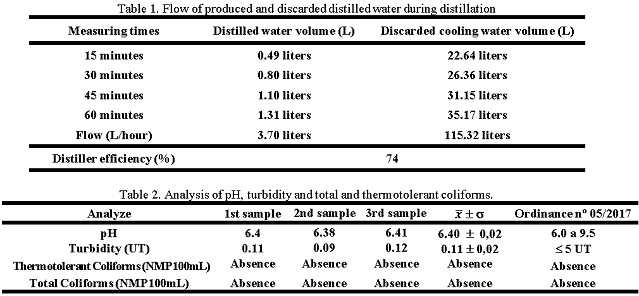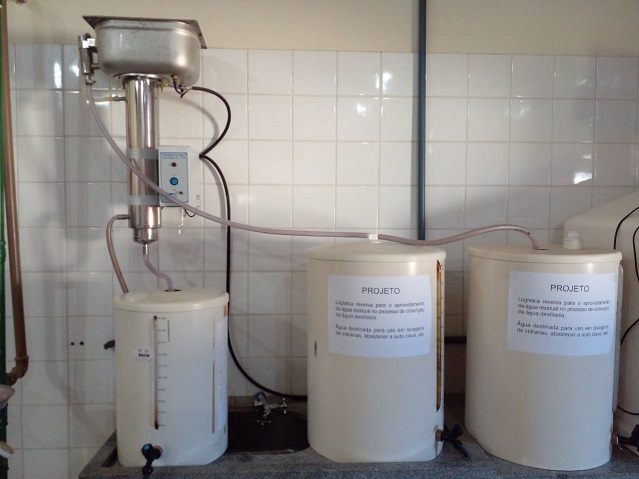Autores
Silva, R.P. (IFTO CAMPUS PARAÍSO DO TOCANTINS) ; Carvalho, N.P. (IFTO CAMPUS PARAÍSO DO TOCANTINS) ; Vivan, J.V. (IFTO CAMPUS PARAÍSO DO TOCANTINS) ; Viroli, S.L.M. (IFTO CAMPUS PARAÍSO DO TOCANTINS)
Resumo
Reverse Logistics reduce pollution by reusing and recycling waste. The quality
and reuse of water discarded during the production of distilled water was
investigated. The study was carried out in an exploratory, descriptive and
quantitative way, evaluating the loss of water during the distillation process in
a Pilsen model water distiller installed in the Food laboratory of the IFTO
campus Paraíso do Tocantins. The pH, turbidity and coliform analyze were
performed according to APHA. The water analysis showed satisfactory potability
quality, and can be reused in washing glassware and producing distilled water. It
is suggested the installation of a reservoir to capture wastewater implanted
below the distiller in the inner part of the laboratory next to the equipment.
Palavras chaves
Water analysis; Distiller; Cooling water
Introdução
Reverse logistics is a set of actions and means aimed at enabling recycling,
reuse, in a sustainable way, requiring a demand for integrated processes to
properly carry out material collection, reprocessing, storage, etc. (MORAIS;
VIDIGAL, 2022). Reverse logistics integrates recycling and correct disposal of
products in their final stage, this means that it is the moment in which the
residue from the consumed product returns to the company, so that it can be
reused, generating raw material or correctly discarded so as not to cause an
impact. environment (RODRIGUES, 2022). In a practical way, Reverse Logistics
aims to reduce pollution, promote the reuse and recycling of waste while
improving the organization's brand and image (NASCIMENTO et al, 2019). Damaged
glassware, solid chemical reagents, liquids and materials used for didactic
purposes in practical chemistry classes generate large amounts of organic and
inorganic materials within educational institutions that need proper treatment
and disposal (LINHARES et al, 2008). The management of waste generated by
Universities, Federal Institutes and Research Centers cannot be neglected, as
waste from chemical products and broken glassware produced in their chemical
laboratories can cause enormous environmental impacts if improperly disposed of
in the environment. (LINHARES et al, 2008). Most of the waste generated during
classes can be recycled or reused (LEITE, 2003). In view of this context, the
practices to reduce waste and rational use of resources were analyzed, the
quality and possibility of reuse of discarded water during the distilled water
production process were researched.
Material e métodos
The study was carried out in an exploratory and descriptive manner with a
quantitative approach (GIL, 2008) evaluating the loss of water during the
distillation process in a Pilsen model water still, with a maximum distillation
capacity of 5 liters per hour (L.h)-1), producing 10 liters of
distilled water running 4 (four) hours a day, installed in the Food Laboratory of
the Federal Institute of Education, Science and Technology (IFTO) on the Paraíso
do Tocantins campus. The amounts of distilled and cooling water were based on the
calculation of the flow during the distillation process. Flow tests were carried
out, where the water was collected in a graduated container, timing the time of
15, 30, 45 and 60 minutes uninterruptedly. For each time, the volume of distilled
and cooling water from the still was measured. After the flow measurements, the
costs with the cooling water discarded by the distiller were compared with the
cost of the treated drinking water. The distiller's efficiency was also verified,
being calculated through the flow in L.h-1 of the distilled water, in
which the food laboratory distiller, according to the manufacturer's manual,
distills 5 L.h-1 when it is working with 100% efficiency. From this
information, it was possible to calculate the operating efficiency of the
distiller. Potential hydrogenonic (pH), turbidity and total (TC) and
thermotolerant (CTT) coliform (CTT) analyzes were performed following the
methodologies of the American Public Health Association (APHA, 2012). The results
of the analyzes were compared with the values of the Consolidation Ordinance No.
05, of September 28, 2017 (BRASIL, 2017). Finally, actions were proposed to
mitigate the waste and reuse of water discarded by the distiller.
Resultado e discussão
Tables 1 and 2 show the results of the still flow test and analysis of pH,
turbidity and total and thermotolerant coliforms, respectively. For the storage
of water for reuse, 50 L barrels were used (figure 1). The distiller showed an
efficiency of 74% producing 3.70 L of distilled water and 115.32 L of water per
hour. 31.16 liters of well water were needed to produce 1 liter of distilled
water. In one month, running 4 hours a day, we will have a disposal of 13.84
m3 of cooling water, which is equivalent to BRL 86.10 reais (BRK,
2021). The results of the analysis of pH, turbidity and total and thermotolerant
coliforms show compliance with the aforementioned legislation, which establishes
the potability parameters. Simões et al (2020), conducting a study on the
analysis of the quality of water discarded in the process for the production of
distilled water, found an efficiency of 73% with production of 3.65 L of
distilled water and disposal of 105.97 L of water, requiring 29 , 02 L of well
water to produce 1 liter of distilled water. According to Pinto, Capri and Capri
Neto (2015) the water discarded from the distillers is not contaminated and has
the characteristics of drinking water. Rodon, Ribeiro Junior and Silva (2017),
Medeiros, Storck, Volpatto, (2017) researching on the reuse of wastewater from
distillers report, it can be reused for cleaning instruments, benches and
equipment used in tests, washing glassware in laboratories and for further
distillations. They corroborate the statements of the authors cited with the
results obtained in this study, using cooling water discarded from the
distillers. Reuse must be practiced in laboratories, and must be designed in the
implementation and construction phase of institutions (SIMÕES et al, 2020).

Table 1. Flow of produced and discarded distilled water during distillation. Table 2. Analysis of pH, turbidity and total and thermotolerant coliforms

Storage of discarded water in the still during the distilled water production process
Conclusões
Given the need for distilled water in the laboratories of the IFTO campus Paraíso
do Tocantins and under the efficiency of the distiller installed in the food
laboratory, there is a waste of 13,000 liters of water, generating a monthly
expense of 86.10 reais. The water analysis showed that the water from the
distiller's refrigeration disposal has satisfactory quality compared to
potability standards, and can be reused for the purpose of washing laboratory
glassware and recirculation in the distiller itself to produce distilled water.
It is suggested, for future works, the installation of a res
Agradecimentos
TO GOD, to the IFTO Paraíso do Tocantins campus
Referências
APHA. American Public Health Association. Standard Methods for the Examination of Water and Wastewater. 22 ed. Washington DC, 2012.
BRK. Tabelas de tarifas – BRK/Saneatins Tocantins. Disponivel em: https://brkambiental.com.br/uploads/31/ santa/
estrutura-tarifaria-tocantins-12-2021.pdf. Acesso em: 5 maio 2022
BRASIL. Ministério da saúde. Portaria de Consolidação nº 05, de 28 de setembro de 2017. Consolidação das normas sobre as ações e os serviços de saúde do Sistema Único de Saúde. Brasília: Diário Oficial da União, 03 out. 2017.
GIL, A. C. Métodos e técnicas de pesquisa social. Antônio Carlos Gil. - 6. ed. - São Paulo: Atlas,2008.
LEITE, P. R. Logística Reversa: Meio Ambiente e competitividade. São Paulo: Prentice Hall, 2003.
LINHARES, A. C. S.; CARDOSO, P. A.; JUNIOR, O. C . Logística reversa: o caso do destino de produtos químicos e vidrarias de uma instituição de ensino profissionalizante em Curitiba. In: ENCONTRO NACIONAL DE ENGENHARIA DE PRODUÇÃO, 28, 2008, Rio de Janeiro. Anais Eletrônicos [...]. Rio de Janeiro, 2008. Disponível: https://abepro.org.br/biblioteca/enegep2008_tn_sto_077_540_11254.pdf. Acesso 12 mar. 2022
MEDEIROS, R. C.; STORCK, W. R.; VOLPATTO, F. Gestão da água de descarte de destiladores de água em Laboratórios de uma IES. In: CONGRESSO BRASILEIRO DE GESTÃO AMBIENTAL, 8., 2017 Campo Grande. Anais...Mato Grosso do Sul: IBEAS, 2017. p.1-4. Disponivel em : https://www.ibeas.org.br/congresso/Trabalhos2017/I-015.pdf. Acesso em: 2 maio 2022.
MORAIS, M. de O.; VIDIGAL, H. . Logística Reversa e Resíduos Sólidos: a importância da conscientização sobre a reciclagem do vidro. Pesquisa, Sociedade e Desenvolvimento. [S. l.] , v. 11, n. 5, pág. e57611528829, 2022. DOI: 10.33448/rsd-v11i5.28829. Disponível em: https://rsdjournal.org/index.php/rsd/article/view/28829. Acesso em: 8 jun. 2022.
NASCIMENTO, M. C.; DOS SANTOS, M. A.; FERREIRA, G. S. A. A Logística Reversa e os Fatores Socioambientais e Econômicos: um estudo de empresas do setor cosméticos e de óleo vegetal. In: Simpósio de Tecnologia da Fatec Sertãozinho, 2(1), 343-353. 2019. https://doi.org/10.33635/sitefa.v2i1.82. Acesso 22 maio 2022.
PINTO, A. C.; CAPRI, M. R.; CAPRI NETO, A. Gestão de água no laboratório: recuperação da água descartada dos destiladores. In: CONGRESSO INTERNACIONAL RESAG – Gestão da água e monitoramento ambiental, 2., 2015, Aracajú. Anais... Aracajú –SE: UNIT, 2015. Disponível em: http://www.resag.org.br/congressoresag2015/anais/img/pdfs
/ID_136.pdf. Acesso em: 2 maio 2022.
RONDON, H. A.; RIBEIRO JUNIOR, I.; SILVA, M.; R.;da. Implantação de um sistema de reúso da água residual do aparelho destilador para laboratório de solos do IFMT. In: ENCONTRO EM ENGENHARIA DE EDIFICAÇÕES E AMBIENTAL – EEEA, 5., 2017, Cuiabá. Anais... Cuiabá–MT: UFMT, 2017. Disponível em: http://eventosacademicos.
ufmt.br/index.php/eeea/eeea 2017/paper/view/5730 Acesso em: 10 abr. 2022
RODRIGUES, RO. Logística Reversa como diferencial competitivo. Pesquisa, Sociedade e Desenvolvimento, [S. l.] , v. 11, n. 6, pág. e36311629354, 2022. DOI: 10.33448/rsd-v11i6.29354. Disponível em: https://rsdjournal.org/index.php/rsd/article/view/29354. Acesso em: 8 jun. 2022.
SIMÕES, F. A. F.; DE FREITAS, C. A. S.; FEITOSA, R. G. F.; SANTOS, Y. T. da C.; COSTA, L. D. A.; PINHO, C. de O.; da SILVA, M. L. Q.; dos SANTOS, S. P. Potencial de reúso das águas de resfriamento de destiladores laboratoriais. Revista Eletrônica de Gestão e Tecnologias Ambientais, [S. l.], v. 8, n. 1, p. 180–194, 2020. DOI: 10.9771/gesta.v8i1.36627. Disponível em: https://periodicos.ufba.br/index.php/gesta/article/view/36627. Acesso em: 05 maio. 2022.
















